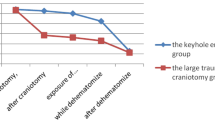Summary
This is an investigation into the prognostic factors of 117 patients with spontaneous normo- and hypertensive intracerebral haematomas, supported by animal experiments. Preserved tissue elastance and fluid conduction enables the drainage of intrinsic haematoma serum into the CSF spaces in normotensive patients, who showed an increased extension of a perifocal hypodensity in the CT. Arterial hypertension decreased the possibility of fluid resolution.
Our experimental studies showed that in hypertensive cases the serum remained trapped in the haematoma, which explains the small hypodense area around the haematoma in most of the hypertensive cases. If as an exception in hypertensives a perifocal hypodensity develops then it acts as additional space-occupying factor. Corresponding observations were made in hypertensive animals which showed a reduced serum movement out of the haematoma, but an increased Evans-Blue content in the perifocal tissue. Both pathological mechanisms explain the poorer prognosis in patients with intracerebral haematomas associated with high arterial blood pressure.
Similar content being viewed by others
References
Durward QJ, Del Maestro RF, Amacher AL, Farrar JK (1983) The influence of systemic arterial pressure on the development of cerebral vasogenic edema. J Neurosurg 59: 803–809
Enzmann DR, Britt RH, Lyons BE, Buxton JL, Wilson DA (1981) Natural history of experimental intracerebral hemorrhage: sonography, computed tomography and neuropathology. AJNR 2: 517–526
Fein JM (1982) Hypertension and the central nervous system. Clin Neurosurg 29: 666–721
Gänshirt H, Keuler R (1980) Intracerebrale Blutungen. Nervenarzt 51: 201–206
Herold S, von Kummer R, Jäger C (1982) Follow-up of spontaneous intracerebral haemorrhage by computed tomography. J Neurol 228: 267–276
Klatzo I (1967) Neuropathological aspects of brain edema. J Neuropathol Exp Neurol 26: 1–14
McKissock W, Richardson A, Taylor J (1961) Primary intracerebral haemorrhage. A controlled trial of surgical and conservative treatment in 180 unselected cases. Lancet II: 221–226
Regli F, Jeanmonod D (1980) Initial clinical course and prognostic factors in ICH. In: Pia HW, Langmaid C, Zierski J (eds) Spontaneous intracerebral haematomas. Springer, Berlin Heidelberg New York, pp 233–240
Reulen HJ, Graham R, Spatz M, Klatzo I (1977) Role of pressure gradients and bulk flow in dynamics of vasogenic brain edema. J Neurosurg 46: 24–35
Reulen HJ, Tsuyumu M, Tack A, Fenske AR, Prioleau GR (1978) Clearance of edema fluid into cerebrospinal fluid. J Neurosurg 48: 754–764
Schürmann K, Dei Anang K (1980) Indication and contraindication for surgery of spontaneous intracerebral haematomas. Neurosurg Rev 3: 17–22
Wallenfang T, Bayer J, Fries G, Schürmann K (1985) Die experimentelle intracerebrale Blutung bei der Katze: Veränderungen des Hirndrucks und des Hirnödems bei unterschiedlichen Kreislaufbedingungen. In: Schürmann K (ed) Der cerebrale Notfall. Urban & Schwarzenberg, München Berlin Wien, pp 183–187
Wilmes F, Hossmann KA (1979) A specific immunofluorescence technique for the demonstration of vasogenic brain edema in paraffin embedded material. Acta Neuropathol (Berl) 45: 47–51
Yoshida Y, Shinkai H, Ooneda G (1983) Morphogenesis of microaneurysms and plasmatic arterionecrosis in hypertensive intracerebral haemorrhage. In: Mizukami Met al (eds) Hypertensive intracerebral hemorrhage. Raven Press, New York, pp 181–190
Author information
Authors and Affiliations
Rights and permissions
About this article
Cite this article
Wallenfang, T., Fries, G., Ulrich, P. et al. Tissue elastance and fluid conduction in normotensive and hypertensive intracerebral mass haematomas. Acta neurochir 95, 28–33 (1988). https://doi.org/10.1007/BF01793079
Issue Date:
DOI: https://doi.org/10.1007/BF01793079




